Non Verbal Communication Research Paper 2022
VerifiedAdded on 2022/09/28
|6
|1575
|50
AI Summary
Contribute Materials
Your contribution can guide someone’s learning journey. Share your
documents today.
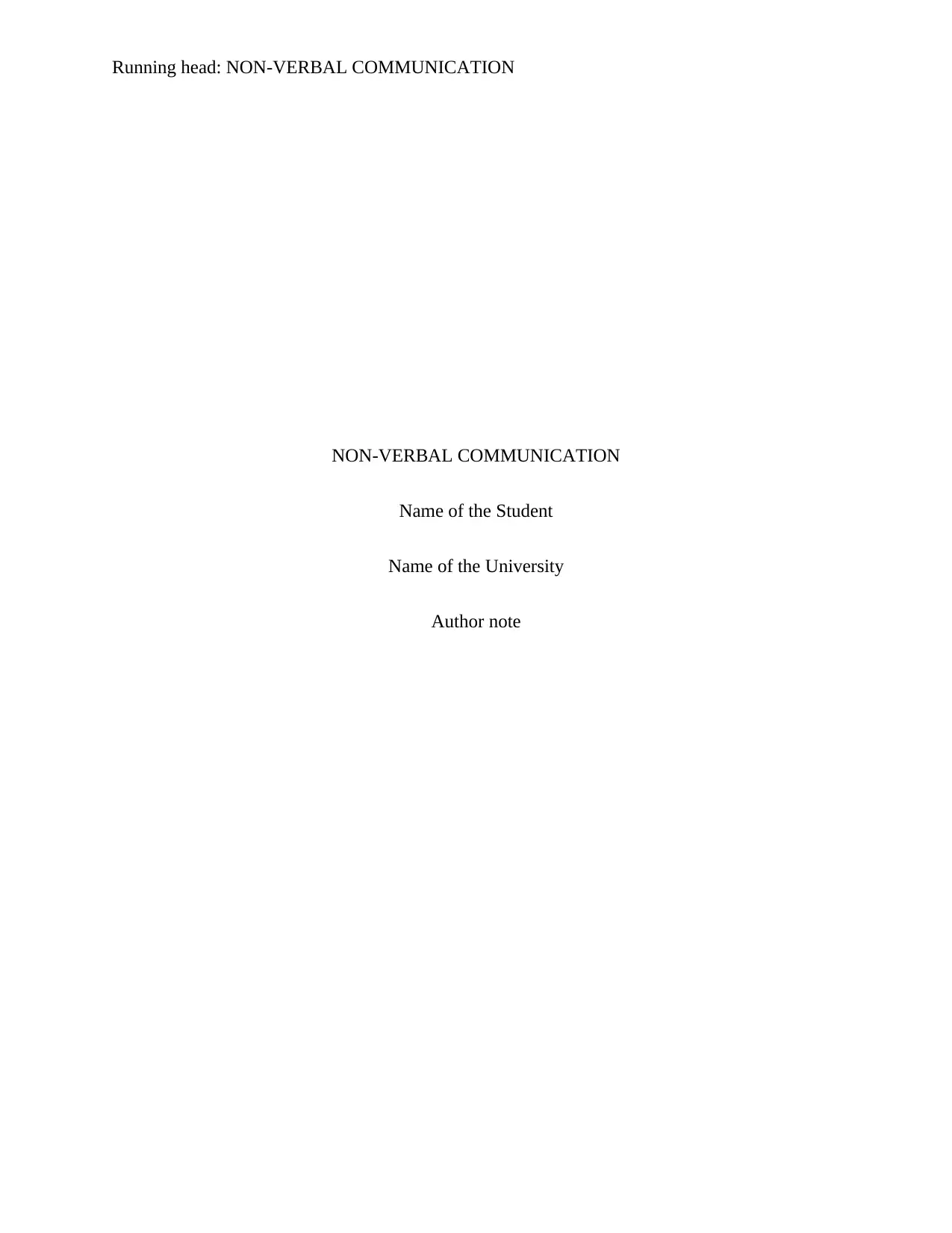
Running head: NON-VERBAL COMMUNICATION
NON-VERBAL COMMUNICATION
Name of the Student
Name of the University
Author note
NON-VERBAL COMMUNICATION
Name of the Student
Name of the University
Author note
Secure Best Marks with AI Grader
Need help grading? Try our AI Grader for instant feedback on your assignments.
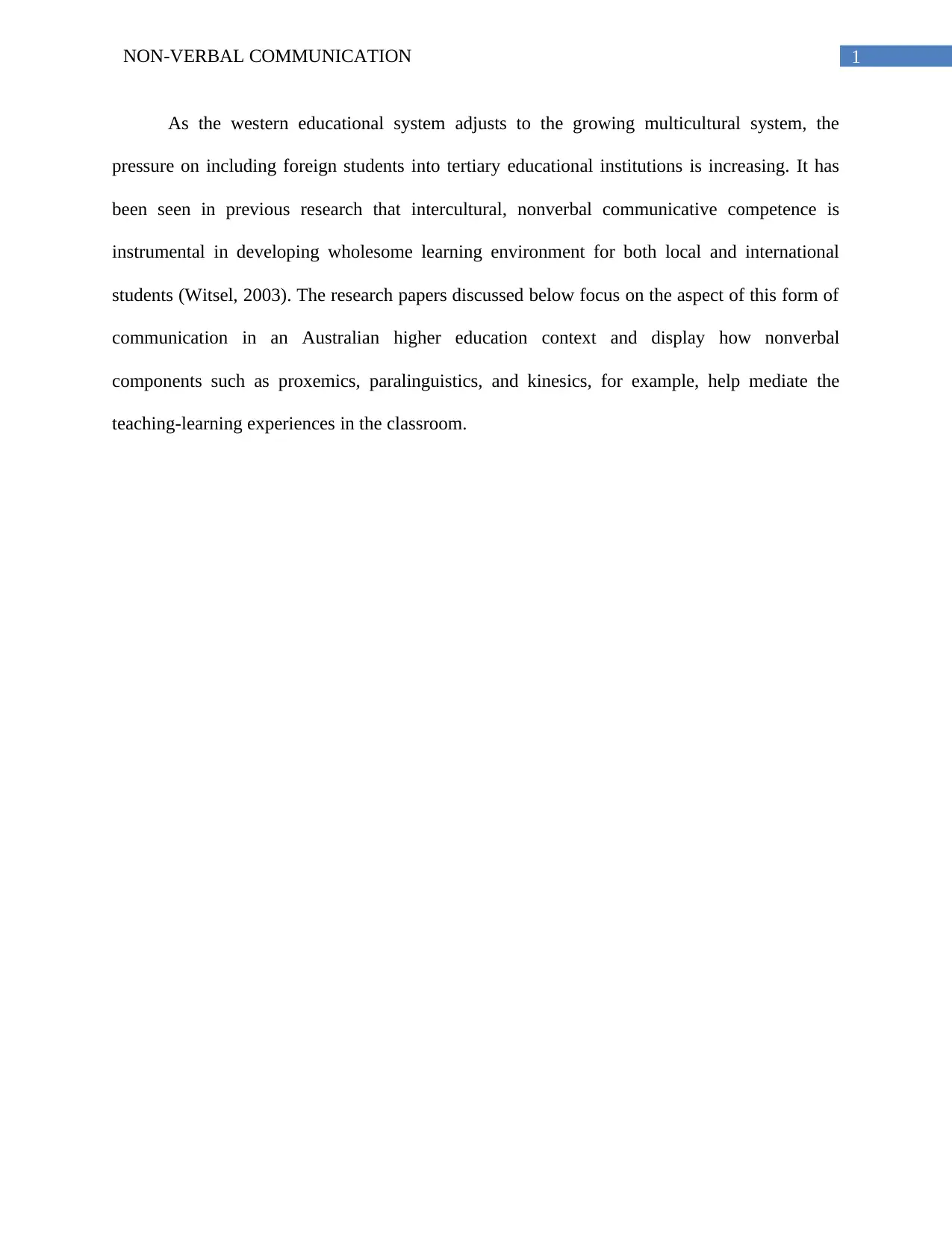
1NON-VERBAL COMMUNICATION
As the western educational system adjusts to the growing multicultural system, the
pressure on including foreign students into tertiary educational institutions is increasing. It has
been seen in previous research that intercultural, nonverbal communicative competence is
instrumental in developing wholesome learning environment for both local and international
students (Witsel, 2003). The research papers discussed below focus on the aspect of this form of
communication in an Australian higher education context and display how nonverbal
components such as proxemics, paralinguistics, and kinesics, for example, help mediate the
teaching-learning experiences in the classroom.
As the western educational system adjusts to the growing multicultural system, the
pressure on including foreign students into tertiary educational institutions is increasing. It has
been seen in previous research that intercultural, nonverbal communicative competence is
instrumental in developing wholesome learning environment for both local and international
students (Witsel, 2003). The research papers discussed below focus on the aspect of this form of
communication in an Australian higher education context and display how nonverbal
components such as proxemics, paralinguistics, and kinesics, for example, help mediate the
teaching-learning experiences in the classroom.
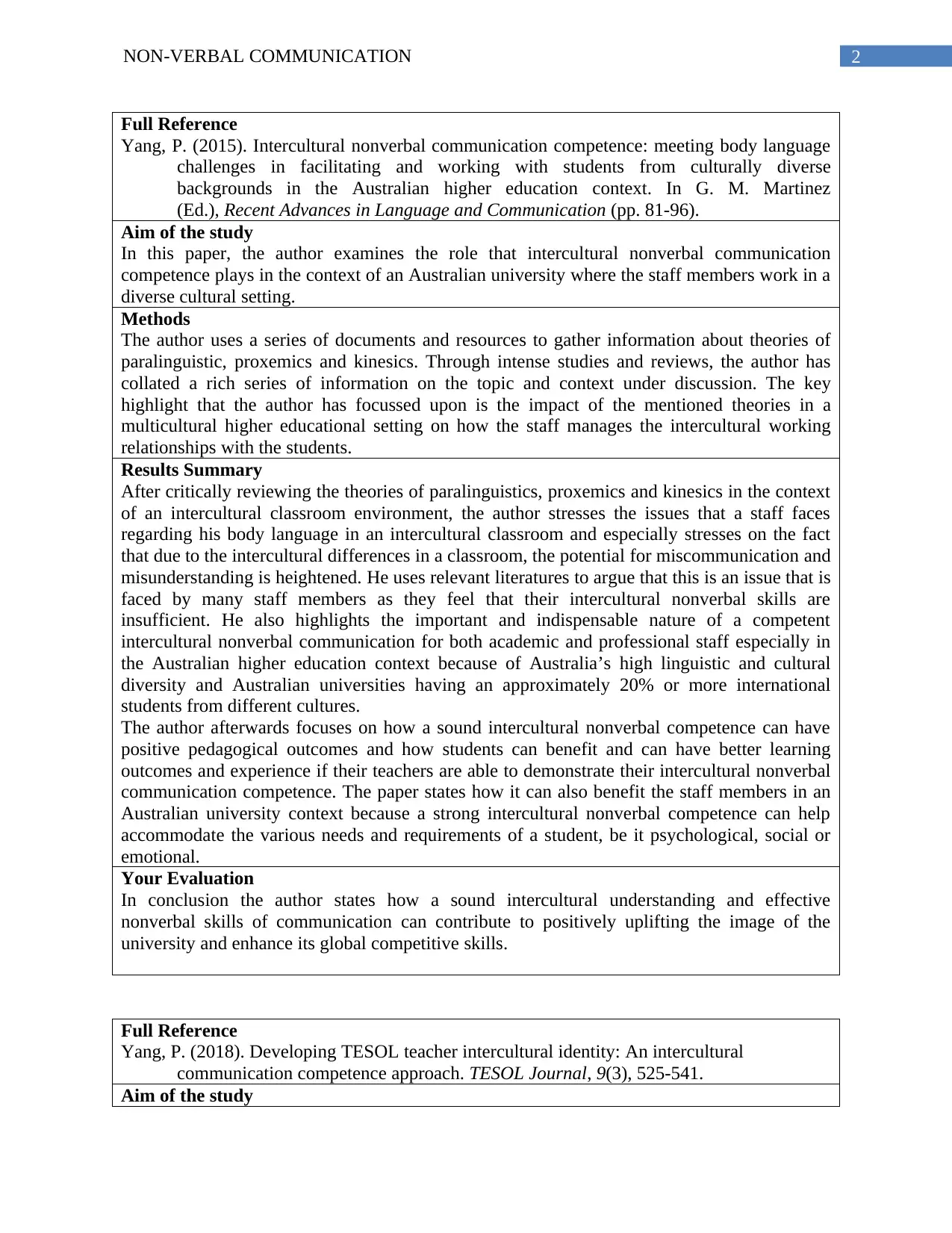
2NON-VERBAL COMMUNICATION
Full Reference
Yang, P. (2015). Intercultural nonverbal communication competence: meeting body language
challenges in facilitating and working with students from culturally diverse
backgrounds in the Australian higher education context. In G. M. Martinez
(Ed.), Recent Advances in Language and Communication (pp. 81-96).
Aim of the study
In this paper, the author examines the role that intercultural nonverbal communication
competence plays in the context of an Australian university where the staff members work in a
diverse cultural setting.
Methods
The author uses a series of documents and resources to gather information about theories of
paralinguistic, proxemics and kinesics. Through intense studies and reviews, the author has
collated a rich series of information on the topic and context under discussion. The key
highlight that the author has focussed upon is the impact of the mentioned theories in a
multicultural higher educational setting on how the staff manages the intercultural working
relationships with the students.
Results Summary
After critically reviewing the theories of paralinguistics, proxemics and kinesics in the context
of an intercultural classroom environment, the author stresses the issues that a staff faces
regarding his body language in an intercultural classroom and especially stresses on the fact
that due to the intercultural differences in a classroom, the potential for miscommunication and
misunderstanding is heightened. He uses relevant literatures to argue that this is an issue that is
faced by many staff members as they feel that their intercultural nonverbal skills are
insufficient. He also highlights the important and indispensable nature of a competent
intercultural nonverbal communication for both academic and professional staff especially in
the Australian higher education context because of Australia’s high linguistic and cultural
diversity and Australian universities having an approximately 20% or more international
students from different cultures.
The author afterwards focuses on how a sound intercultural nonverbal competence can have
positive pedagogical outcomes and how students can benefit and can have better learning
outcomes and experience if their teachers are able to demonstrate their intercultural nonverbal
communication competence. The paper states how it can also benefit the staff members in an
Australian university context because a strong intercultural nonverbal competence can help
accommodate the various needs and requirements of a student, be it psychological, social or
emotional.
Your Evaluation
In conclusion the author states how a sound intercultural understanding and effective
nonverbal skills of communication can contribute to positively uplifting the image of the
university and enhance its global competitive skills.
Full Reference
Yang, P. (2018). Developing TESOL teacher intercultural identity: An intercultural
communication competence approach. TESOL Journal, 9(3), 525-541.
Aim of the study
Full Reference
Yang, P. (2015). Intercultural nonverbal communication competence: meeting body language
challenges in facilitating and working with students from culturally diverse
backgrounds in the Australian higher education context. In G. M. Martinez
(Ed.), Recent Advances in Language and Communication (pp. 81-96).
Aim of the study
In this paper, the author examines the role that intercultural nonverbal communication
competence plays in the context of an Australian university where the staff members work in a
diverse cultural setting.
Methods
The author uses a series of documents and resources to gather information about theories of
paralinguistic, proxemics and kinesics. Through intense studies and reviews, the author has
collated a rich series of information on the topic and context under discussion. The key
highlight that the author has focussed upon is the impact of the mentioned theories in a
multicultural higher educational setting on how the staff manages the intercultural working
relationships with the students.
Results Summary
After critically reviewing the theories of paralinguistics, proxemics and kinesics in the context
of an intercultural classroom environment, the author stresses the issues that a staff faces
regarding his body language in an intercultural classroom and especially stresses on the fact
that due to the intercultural differences in a classroom, the potential for miscommunication and
misunderstanding is heightened. He uses relevant literatures to argue that this is an issue that is
faced by many staff members as they feel that their intercultural nonverbal skills are
insufficient. He also highlights the important and indispensable nature of a competent
intercultural nonverbal communication for both academic and professional staff especially in
the Australian higher education context because of Australia’s high linguistic and cultural
diversity and Australian universities having an approximately 20% or more international
students from different cultures.
The author afterwards focuses on how a sound intercultural nonverbal competence can have
positive pedagogical outcomes and how students can benefit and can have better learning
outcomes and experience if their teachers are able to demonstrate their intercultural nonverbal
communication competence. The paper states how it can also benefit the staff members in an
Australian university context because a strong intercultural nonverbal competence can help
accommodate the various needs and requirements of a student, be it psychological, social or
emotional.
Your Evaluation
In conclusion the author states how a sound intercultural understanding and effective
nonverbal skills of communication can contribute to positively uplifting the image of the
university and enhance its global competitive skills.
Full Reference
Yang, P. (2018). Developing TESOL teacher intercultural identity: An intercultural
communication competence approach. TESOL Journal, 9(3), 525-541.
Aim of the study
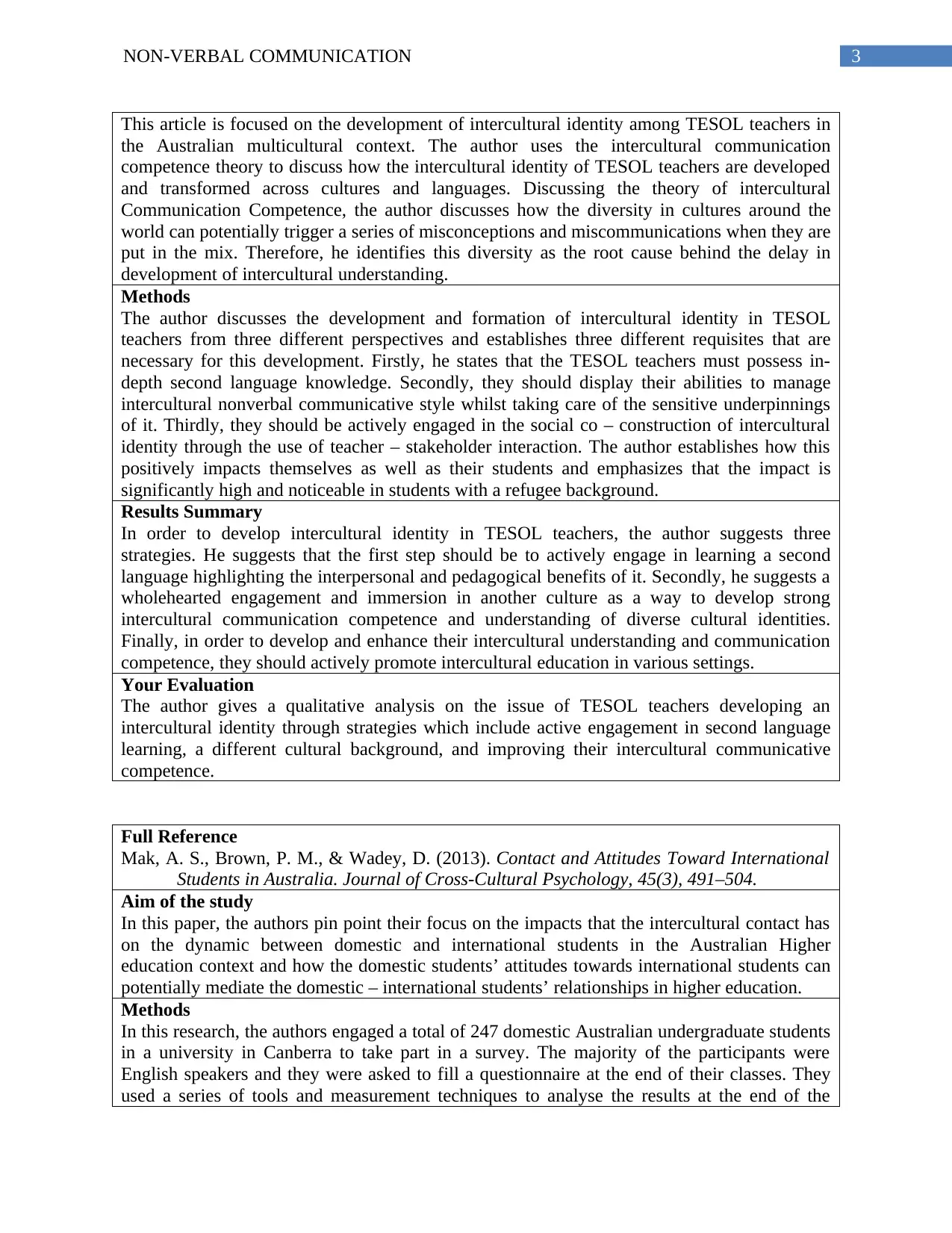
3NON-VERBAL COMMUNICATION
This article is focused on the development of intercultural identity among TESOL teachers in
the Australian multicultural context. The author uses the intercultural communication
competence theory to discuss how the intercultural identity of TESOL teachers are developed
and transformed across cultures and languages. Discussing the theory of intercultural
Communication Competence, the author discusses how the diversity in cultures around the
world can potentially trigger a series of misconceptions and miscommunications when they are
put in the mix. Therefore, he identifies this diversity as the root cause behind the delay in
development of intercultural understanding.
Methods
The author discusses the development and formation of intercultural identity in TESOL
teachers from three different perspectives and establishes three different requisites that are
necessary for this development. Firstly, he states that the TESOL teachers must possess in-
depth second language knowledge. Secondly, they should display their abilities to manage
intercultural nonverbal communicative style whilst taking care of the sensitive underpinnings
of it. Thirdly, they should be actively engaged in the social co – construction of intercultural
identity through the use of teacher – stakeholder interaction. The author establishes how this
positively impacts themselves as well as their students and emphasizes that the impact is
significantly high and noticeable in students with a refugee background.
Results Summary
In order to develop intercultural identity in TESOL teachers, the author suggests three
strategies. He suggests that the first step should be to actively engage in learning a second
language highlighting the interpersonal and pedagogical benefits of it. Secondly, he suggests a
wholehearted engagement and immersion in another culture as a way to develop strong
intercultural communication competence and understanding of diverse cultural identities.
Finally, in order to develop and enhance their intercultural understanding and communication
competence, they should actively promote intercultural education in various settings.
Your Evaluation
The author gives a qualitative analysis on the issue of TESOL teachers developing an
intercultural identity through strategies which include active engagement in second language
learning, a different cultural background, and improving their intercultural communicative
competence.
Full Reference
Mak, A. S., Brown, P. M., & Wadey, D. (2013). Contact and Attitudes Toward International
Students in Australia. Journal of Cross-Cultural Psychology, 45(3), 491–504.
Aim of the study
In this paper, the authors pin point their focus on the impacts that the intercultural contact has
on the dynamic between domestic and international students in the Australian Higher
education context and how the domestic students’ attitudes towards international students can
potentially mediate the domestic – international students’ relationships in higher education.
Methods
In this research, the authors engaged a total of 247 domestic Australian undergraduate students
in a university in Canberra to take part in a survey. The majority of the participants were
English speakers and they were asked to fill a questionnaire at the end of their classes. They
used a series of tools and measurement techniques to analyse the results at the end of the
This article is focused on the development of intercultural identity among TESOL teachers in
the Australian multicultural context. The author uses the intercultural communication
competence theory to discuss how the intercultural identity of TESOL teachers are developed
and transformed across cultures and languages. Discussing the theory of intercultural
Communication Competence, the author discusses how the diversity in cultures around the
world can potentially trigger a series of misconceptions and miscommunications when they are
put in the mix. Therefore, he identifies this diversity as the root cause behind the delay in
development of intercultural understanding.
Methods
The author discusses the development and formation of intercultural identity in TESOL
teachers from three different perspectives and establishes three different requisites that are
necessary for this development. Firstly, he states that the TESOL teachers must possess in-
depth second language knowledge. Secondly, they should display their abilities to manage
intercultural nonverbal communicative style whilst taking care of the sensitive underpinnings
of it. Thirdly, they should be actively engaged in the social co – construction of intercultural
identity through the use of teacher – stakeholder interaction. The author establishes how this
positively impacts themselves as well as their students and emphasizes that the impact is
significantly high and noticeable in students with a refugee background.
Results Summary
In order to develop intercultural identity in TESOL teachers, the author suggests three
strategies. He suggests that the first step should be to actively engage in learning a second
language highlighting the interpersonal and pedagogical benefits of it. Secondly, he suggests a
wholehearted engagement and immersion in another culture as a way to develop strong
intercultural communication competence and understanding of diverse cultural identities.
Finally, in order to develop and enhance their intercultural understanding and communication
competence, they should actively promote intercultural education in various settings.
Your Evaluation
The author gives a qualitative analysis on the issue of TESOL teachers developing an
intercultural identity through strategies which include active engagement in second language
learning, a different cultural background, and improving their intercultural communicative
competence.
Full Reference
Mak, A. S., Brown, P. M., & Wadey, D. (2013). Contact and Attitudes Toward International
Students in Australia. Journal of Cross-Cultural Psychology, 45(3), 491–504.
Aim of the study
In this paper, the authors pin point their focus on the impacts that the intercultural contact has
on the dynamic between domestic and international students in the Australian Higher
education context and how the domestic students’ attitudes towards international students can
potentially mediate the domestic – international students’ relationships in higher education.
Methods
In this research, the authors engaged a total of 247 domestic Australian undergraduate students
in a university in Canberra to take part in a survey. The majority of the participants were
English speakers and they were asked to fill a questionnaire at the end of their classes. They
used a series of tools and measurement techniques to analyse the results at the end of the
Secure Best Marks with AI Grader
Need help grading? Try our AI Grader for instant feedback on your assignments.
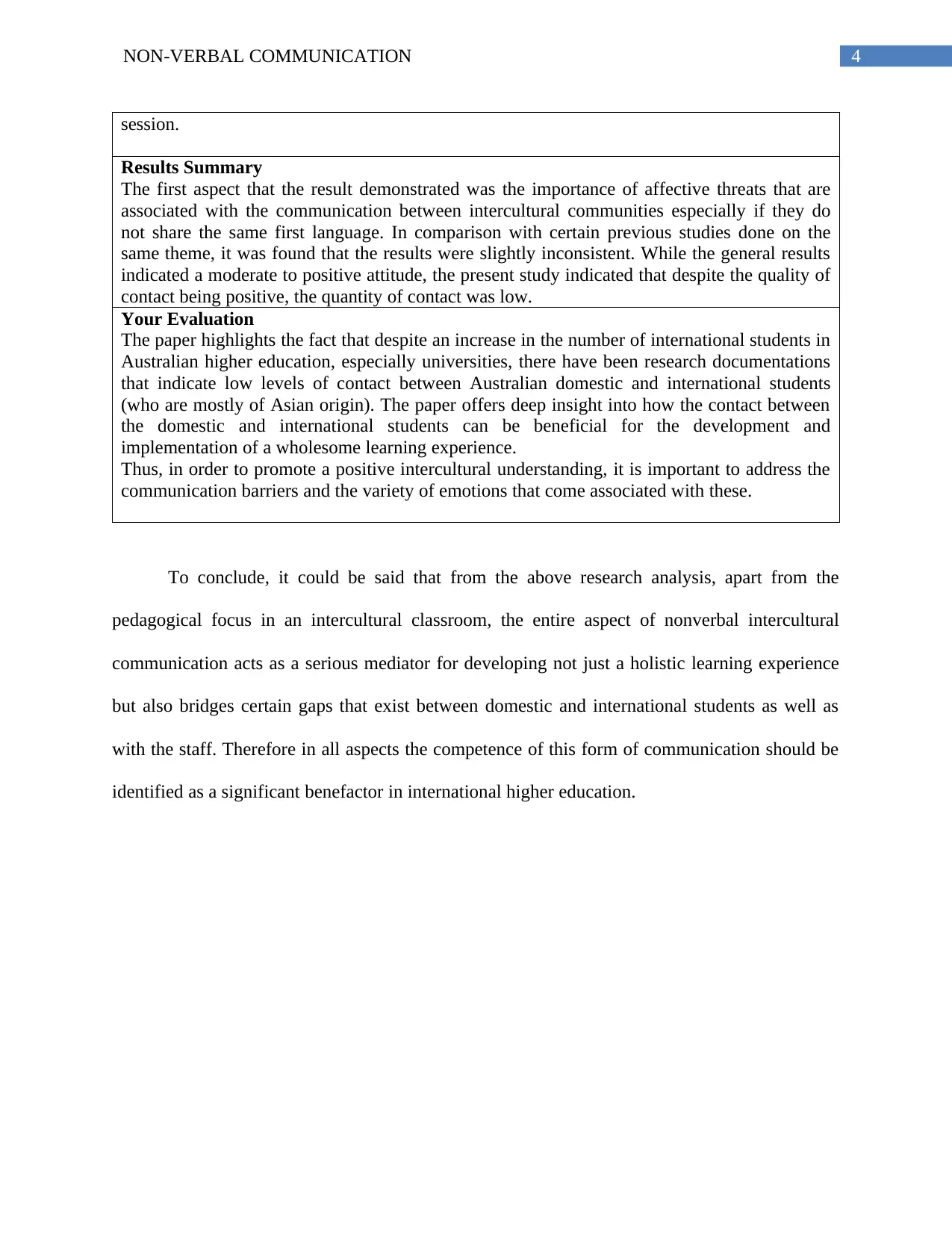
4NON-VERBAL COMMUNICATION
session.
Results Summary
The first aspect that the result demonstrated was the importance of affective threats that are
associated with the communication between intercultural communities especially if they do
not share the same first language. In comparison with certain previous studies done on the
same theme, it was found that the results were slightly inconsistent. While the general results
indicated a moderate to positive attitude, the present study indicated that despite the quality of
contact being positive, the quantity of contact was low.
Your Evaluation
The paper highlights the fact that despite an increase in the number of international students in
Australian higher education, especially universities, there have been research documentations
that indicate low levels of contact between Australian domestic and international students
(who are mostly of Asian origin). The paper offers deep insight into how the contact between
the domestic and international students can be beneficial for the development and
implementation of a wholesome learning experience.
Thus, in order to promote a positive intercultural understanding, it is important to address the
communication barriers and the variety of emotions that come associated with these.
To conclude, it could be said that from the above research analysis, apart from the
pedagogical focus in an intercultural classroom, the entire aspect of nonverbal intercultural
communication acts as a serious mediator for developing not just a holistic learning experience
but also bridges certain gaps that exist between domestic and international students as well as
with the staff. Therefore in all aspects the competence of this form of communication should be
identified as a significant benefactor in international higher education.
session.
Results Summary
The first aspect that the result demonstrated was the importance of affective threats that are
associated with the communication between intercultural communities especially if they do
not share the same first language. In comparison with certain previous studies done on the
same theme, it was found that the results were slightly inconsistent. While the general results
indicated a moderate to positive attitude, the present study indicated that despite the quality of
contact being positive, the quantity of contact was low.
Your Evaluation
The paper highlights the fact that despite an increase in the number of international students in
Australian higher education, especially universities, there have been research documentations
that indicate low levels of contact between Australian domestic and international students
(who are mostly of Asian origin). The paper offers deep insight into how the contact between
the domestic and international students can be beneficial for the development and
implementation of a wholesome learning experience.
Thus, in order to promote a positive intercultural understanding, it is important to address the
communication barriers and the variety of emotions that come associated with these.
To conclude, it could be said that from the above research analysis, apart from the
pedagogical focus in an intercultural classroom, the entire aspect of nonverbal intercultural
communication acts as a serious mediator for developing not just a holistic learning experience
but also bridges certain gaps that exist between domestic and international students as well as
with the staff. Therefore in all aspects the competence of this form of communication should be
identified as a significant benefactor in international higher education.
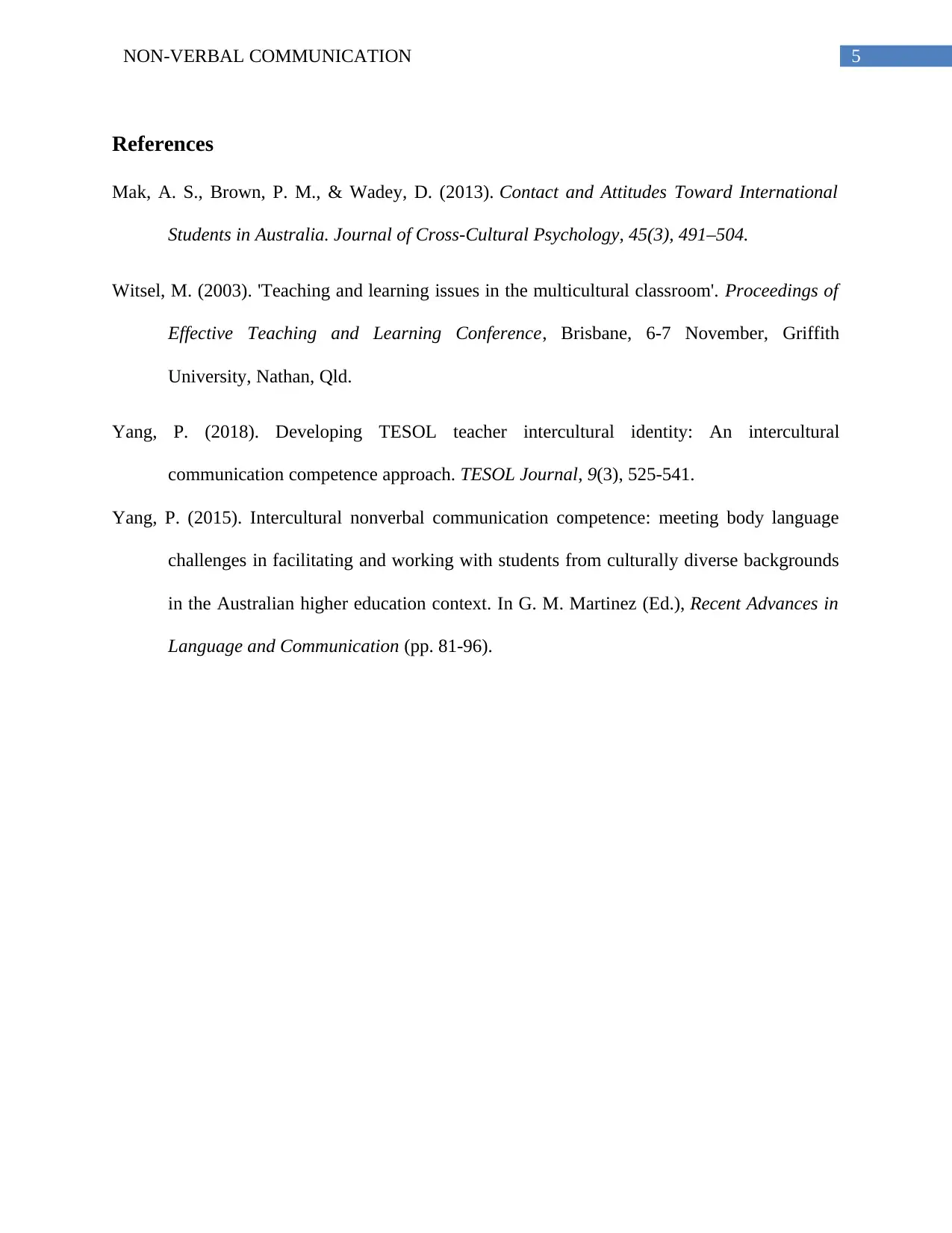
5NON-VERBAL COMMUNICATION
References
Mak, A. S., Brown, P. M., & Wadey, D. (2013). Contact and Attitudes Toward International
Students in Australia. Journal of Cross-Cultural Psychology, 45(3), 491–504.
Witsel, M. (2003). 'Teaching and learning issues in the multicultural classroom'. Proceedings of
Effective Teaching and Learning Conference, Brisbane, 6-7 November, Griffith
University, Nathan, Qld.
Yang, P. (2018). Developing TESOL teacher intercultural identity: An intercultural
communication competence approach. TESOL Journal, 9(3), 525-541.
Yang, P. (2015). Intercultural nonverbal communication competence: meeting body language
challenges in facilitating and working with students from culturally diverse backgrounds
in the Australian higher education context. In G. M. Martinez (Ed.), Recent Advances in
Language and Communication (pp. 81-96).
References
Mak, A. S., Brown, P. M., & Wadey, D. (2013). Contact and Attitudes Toward International
Students in Australia. Journal of Cross-Cultural Psychology, 45(3), 491–504.
Witsel, M. (2003). 'Teaching and learning issues in the multicultural classroom'. Proceedings of
Effective Teaching and Learning Conference, Brisbane, 6-7 November, Griffith
University, Nathan, Qld.
Yang, P. (2018). Developing TESOL teacher intercultural identity: An intercultural
communication competence approach. TESOL Journal, 9(3), 525-541.
Yang, P. (2015). Intercultural nonverbal communication competence: meeting body language
challenges in facilitating and working with students from culturally diverse backgrounds
in the Australian higher education context. In G. M. Martinez (Ed.), Recent Advances in
Language and Communication (pp. 81-96).
1 out of 6
Related Documents
Your All-in-One AI-Powered Toolkit for Academic Success.
+13062052269
info@desklib.com
Available 24*7 on WhatsApp / Email
![[object Object]](/_next/static/media/star-bottom.7253800d.svg)
Unlock your academic potential
© 2024 | Zucol Services PVT LTD | All rights reserved.




